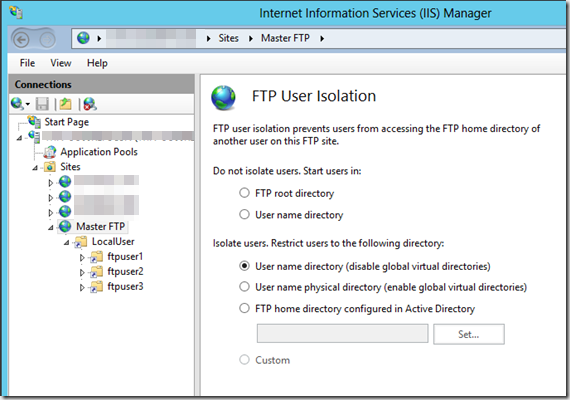
December 3, 2014 05:09 by
 Peter
PeterWhen IIS 7 was released the FTP service were totally redesigned from the bottom up along with security on your mind. This was a welcome change indeed from IIS 6. Along with supporting FTP more than SSL it introduced FTP User Isolation.

Multiple users on a similar FTP website could possibly be separated no matter that file path they had been becoming logged into without risk of somebody traversing up parent paths with other user folders.

The FTP Authorization guidelines cause it to be simple to determine multiple users or perhaps local groups to get access to the FTP server. The user isolation is achieved by making a virtual directory referred to as LocalUser then selecting User name directory (disable global virtual directories). The LocalUser virtual directory ought to purpose towards the FTP root directory then you build a separate virtual directory for every FTP user that points to their destination path.
Along with FTP User Isolation configured your users can never have the ability to transfer up as much as a parent path beyond their individual root directory. Even if a user were able to accurately guess the username and virtual path of another FTP account upon the server they won't have the ability to achieve it. Because of the confines from the isolation the FTP session can not notice anything upon the server. In the illustration down below I login along with local account ftpuser2 and plan to change the path to/ftpuser1 but that path doesn't exist and hence isn't accessible to my user.

Conclusion
IIS 8 on Windows Server 2012 provides the foremost secure FTP service of any IIS version to day. You've multiple layers of FTP security accessible by leveraging FTP Logon Attempt Restrictions, FTP Over SSL, and FTP User Isolation. Your FTP server will certainly be nicely protected using these built-in modules. Along with internet security there isn't any ‘patch’ for complacence. A lot of security is usually much better so implement it when it’s readily accessible for you.